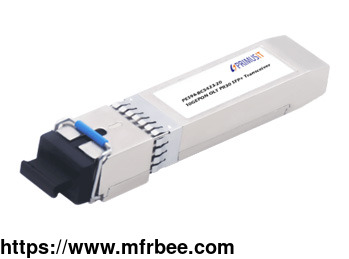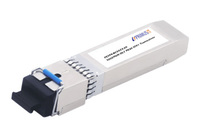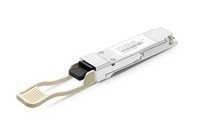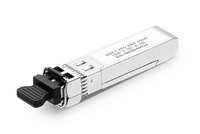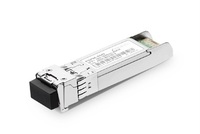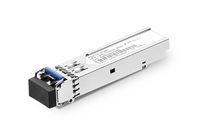10G SYMMETRIC EPON
Specifications
Symmetrical mode: That is, the uplink and downlink rates are both 10G. The asymmetric mode can be considered as a transitional form of the symmetric mode. In the early stage where the upstream
bandwidth demand is less and the cost is more sensitive, the asymmetric mode can be used. With the development of business and technological progress, it will gradually transition to asymmetrical
model. And Primus IT internet fibre 10G EPON is a good choice to follow this model.
Specifications of Internet Fibre Free 10G EPON
P/N GPON 10gProduct Description Data Sheet Data Rate(Gbit/s) TX RX TX_Min(dBm) TX_Max(dBm) RX_Min(dBm) RX_Max(dBm) Power Consumption Reach Temperature(degC)
PES96-B2510 10G EPON Symmetric ONU SFP+ √ 10.3125Gbps DFB 1270nm 1577nm APD-TIA 1260nm 1280nm 1575nm 1580nm / 10km 0 to +70°C
PXS96-B2520 10G XGSPON ONU SFP+ √ 9.95328Gbps DFB 1270nm 1577nm APD-TIA 1260nm 1280nm 1575nm 1580nm / 20km 0 to +70°C
PXS96-B5220 10G EPON Symmetric ONU SFP+ √ 9.953Gbps EML 1577nm 1270nm APD-TIA 1575nm 1580nm 1260nm 1280nm / 20km
What is EPON network?
EPON (Ethernet Passive Optical Network) is a PON technology based on Ethernet. It adopts point-to-multipoint structure, passive optical fiber transmission, and provides a variety of services over
Ethernet. EPON technology combines Ethernet and PON technology, adopts PON technology in the physical layer, uses Ethernet protocol in the data link layer, and uses the topology structure of PON to
realize Ethernet access.
EPON is a new broadband access technology, which realizes the integrated service access of data, voice and video through a single optical fiber access system, and has good economy. It combines the
advantages of PON technology and Ethernet technology: low cost, high bandwidth, strong expansibility, compatibility with existing Ethernet, convenient management and so on. People in the industry
generally believe that FTTH is the final solution for broadband access, and EPON will also become a mainstream broadband access technology.
What is 10g EPON(GEPON) OLT ?
EPON (Ethernet Passive Optical Network), has the characteristic of saving optical resources and is transparent to network protocols. EPON uses a single optical fiber to connect the OLT, and then
the OLT connects the ONU. The free 10g EPON OLT device is an important local device. It can be connected to the switch at the front end by using internet fibre 10g epon cables and connected to the
optical splitter at the client end by using a single optical fiber. Fibre techno free 10g epon can realize the control and management of the client device. Like the ONU equipment, it is also a
photoelectric integrated equipment.
EPON vs. GPON vs. 10G-EPON
EPON is a kind of PON network. The EPON network consists of OLT, ODN, and ONU. The main features are point-to-multipoint, passive line, simple and clear network layer, providing comprehensive
access to voice, broadband, CATV, etc. The EPON system uses upstream and downstream symmetric transmission with a nominal rate of 1.25 GB. The STANDARD of EPON is IEEE 802.3AH, which is based on
gigabit Ethernet technology and realizes PON point-to-multipoint transmission through point-to-multipoint control protocol (MPCP) on MAC layer. The protocol is simple to implement, but the OAM
capability is relatively weak. While the STANDARD of GPON is ITU-T G.984 series, which follows the standard protocol framework of APON and adds GEM, a new frame encapsulation method of TC layer. It
has strict regulations on QoS and OAM, and has a strong capacity to carry TDM services and relatively complex protocol. GPON has a high transmission rate and shunt ratio, providing TDM services
with high timing accuracy. As for the internet fibre techno free 10G-EPON, it is developed on the basis of EPON, and the two are basically the same in technical principle, but the free 10G-EPON has
a stronger carrying capacity.
Internet fibre 10g epon will be used in FTTB/C/N
At present, the mainstream PON technology has made significant progress and began to deploy on a large scale. Free 10g EPON technology has made a breakthrough in technical standards, equipment
function and performance, interoperability, industry chain and cost, while fibra gpon technology has also made great progress in standards, core components, equipment function and performance,
equipment cost and so on. Domestic and foreign operators have also begun to carry out GPON trial commercial or commercial use. All these mark the maturity and large-scale application of the second
generation PON technology (the first generation refers to the traditional narrowband PON).
On the other hand, some new services (such as HDTV, TelePresence and other services) and new network deployment methods also put forward higher requirements for PON technology. In the deployment
mode of FTTB/C/N, each ONU covers more than a dozen or more users, and the number of users covered by each PON port can reach 512 or more, so the current EPON and GPON have deficiencies in
capacity. With the maturity of 10Gbps technology, driven by this business demand, the industry began to research and develop the next generation PON technology with higher transmission capacity,
stronger business support capacity and more perfect management and control functions.
If you are looking for reliable fiber optic transceiver manufacturers, please contact us, and we will be your best partner.
As one of the most professional fiber optic transceiver manufacturers, Primus IT specializes in the development and manufacture 100 bases to 400G optical transceivers ( GBIC / SFP / SFP+/ SFP28 /
QSFP+ / QSFP28 / XFP / XENPAK / X2 / CFP / CFP2 / AOC / DAC etc.) and provides cost-effective transceivers solutions for customers worldwide in data communications, long-distance transmission,
wireless networking and more.
- Country: Afghanistan
- Business Type: Manufacturer
- Market: Americas,Europe
- Address: RM A713, Building Languang Technology, No.27, Gaoxin North 6th Road, Songpingshan Community, Xili Street, Nanshan District, Shenzhen,China
- Contact: primusit .com
